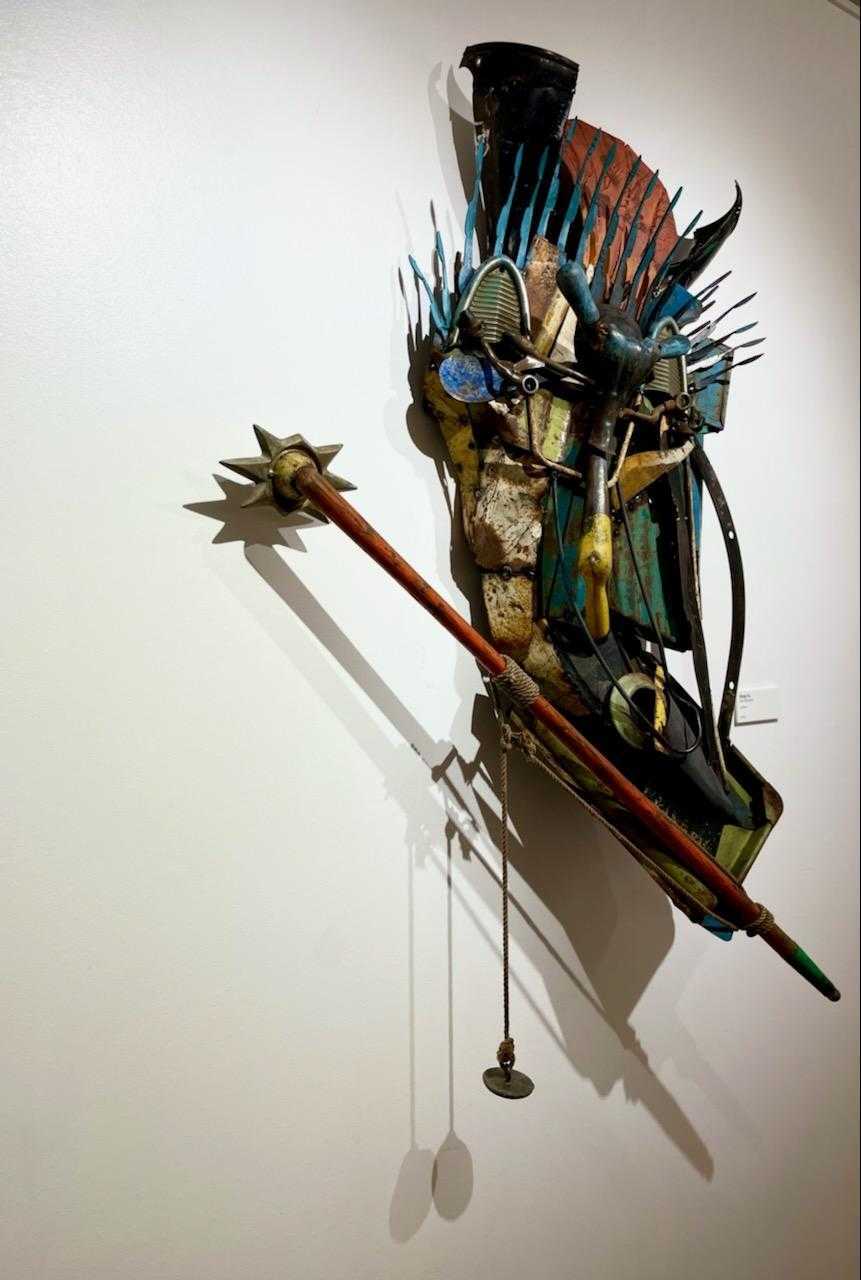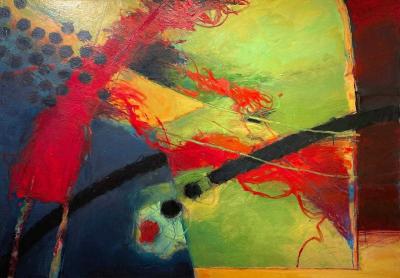Art Review: Ron Bayuzick
Quiet Parts Out Loud at Kada Gallery
"I start with Twombly."
Ron Bayuzick's latest collection of drawings, paintings, and sculpture once again confirms the artist as an important visual expressionist, not only in this region, but beyond. Bayuzick's two- dimensional work dominates his show with abstract pieces varying from medium to large sizes. The majority of the works are not only prodigious in size, but they have a visual presence that expands where one's eye can go while viewing them. Erratic lines are thrust across the surface where they explode into clouds of color. These colors are not fey impressionist colors; they are deep rich reds and aggressive oranges that punch as opposed to pulling you in as a soft pastel would.
As much as color dominates the drawings and paintings, it's the line that I was most intrigued by. Bayuisk will use a straight geometric line to pierce the organic space so as to separate one area from another. In a couple of works, a right angle was used to contain an area so that it is seen as a "space within a space" or in order to cut a painting's surface in half. The unbound lines relate to the artist's statement about Cy Twombly, the American abstract painter who is known for his childlike scribbles and ethereal surface content – here Bayuzick's lines also move and shake, loop and curve around the works. Though he doesn't share the influence of romantic symbolism with Cy Twombly, Bayuzick can paint flora with the same loose flash. His flowers vibrate and shake their colors loose as if possessed from within. Movement is a dominating theme within Bayuzick's paintings: the colors pulse, the lines shutter and break across the plane. There is nowhere for your eye to rest, and you feel like you are watching an event taking place before you. I can almost hear a revving engine under the canvas.

Bayuzik's sculpture is another matter. These pieces are weighted by their subdued colors, natural materials, and rust. In one large piece "Kingfu" – the artist has combined sharp points, rope, a spiked spear-like weapon, and, in the center, an animal skull made from shaped metal and wooden tool handles – has a quiet, post-apocalyptic menace to it. Bayuzick mentioned Twombly as an influence on his paintings, but his assemblages are connected to Ed Kienholz, the Ferus Gallery artist who was known for his found object constructions of moments in everyday life. Bayuzick's pieces don't have the vulgarity and political overtones of Kienholz's but instead have introspective and philosophical elements that encourage viewers to reflect on their own past. In these three-dimensional works, it's not the artist's hand that's doing the work; it's the artist's mind. The ability to choose and pair together found parts to create a larger whole is a different skill set altogether from that of the painter.
Personally, I'm not always sure what I think of assemblage as an art form. The objects tend to have beauty and history already, and in many cases could exist as small works of art themselves. The small model boats, wooden duck heads, cages, and other artifacts in Bayuzik's sculptures already possess a form of what the Japanese call "Wabi-Sabi" or, in other words, something that becomes beautiful as it ages. The artist here is not so much "creating" art as he is combining the exquisite objects to make one fascinating piece. Like a conductor with a top-notch orchestra who brings each instrument to work together with the otherss to create a symphony. Is some of the originality of the work lost when the artist starts with wonderful pieces? That question is up to the viewer to answer, but in this case I doubt many would find fault in Bayuzick's end result. His sculptures make you reflect, smile, imagine, and think, and that is all we could want from them.
One last point I've mentioned before and about which I feel very strongly: there was too much work in too small a space. I could have seen half the work and enjoyed it twice as much. This cramming of artworks onto every surface is distracting and does a disservice to the art itself. The viewer's eyes never rest, and the pieces become a blur. Unfortunately, under these conditions, shows become more about commerce than about the viewing of artwork. The more you can show, the more you can sell. I understand that both the owner of the space and the artist make a living from sales – but the full walls keep me from really considering these places "galleries." To me a gallery, ideally, is a place to showcase artwork at its best, presented in a way that allows the viewer to perceive clearly what the artist is saying. My eyes should be able to focus on a work without other works glaring in my peripheral vision. I can understand the desire to show as much good work as possible, especially when working with an artist with a prodigious output, but I feel the work suffers when crowded. In this case, it is too much of a good thing.
Ron Bayuzick's "Quiet Parts Out Loud" runs until Apr. 29 at Kada Gallery, 2632 West 8th St. // For more info: facebook.com/kadagallery


.png)
